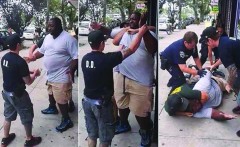
By Sebastien Malo
NEW YORK (Reuters) – In the Staten Island neighborhood where a Black father of six died after police put him in a banned chokehold while arresting him for illegal cigarette sales, a painted tribute on a wall reads “His name was Eric Garner. Father, son and friend….”
Garner lived and died in Tompkinsville, a neighborhood tucked on the north shore of New York’s least populated borough, Staten Island, which is braced for a grand jury’s decision whether to indict the New York Police Department officer who put Garner, 43, in the chokehold.
Residents of the rapidly changing neighborhood, a diversifying corner of the city’s whitest borough, said they would be angry if the grand jury decides not to charge the officer, Daniel Pantaleo, who is white. But none expected violence similar to what was seen in the St. Louis suburb of Ferguson, Missouri, after a grand jury decided not to charge a white police officer who fatally shot an unarmed Black teen.
A memorial of white flowers and hand-written notes marks the spot on a sidewalk where Garner died on July 17 as police officers piled on top of him and used a chokehold, which is banned by the department’s patrol manual, as they tried to arrest him on suspicion of selling untaxed cigarettes. The incident was captured in a video widely viewed on the Internet.
Workers nearby noted that an August protest march through the neighborhood passed without police making a single arrest.
Ahead of that march, merchants had consulted each other about shutting down for the day, said Curtis Hurst, a manager at a furniture and appliance store. This time around, there have been no such talks, he said.
“I don’t foresee anybody making the decision to close,” Hurst said. Drawing a comparison with Ferguson, he added: “The violent protests they had there won’t carry over here.”
The grand jury’s decision could come any day. Pantaleo testified to the panel on Nov. 21 for two hours, said his attorney, Stuart London, who believes the officer was the last witness to testify.
The case sparked debate about police use of force, with officials at both the local police union and New York Civil Liberties Union complaining that officers were not sufficiently trained on how to safely restrain people.
USE OF FORCE
Staten Island is different from New York City’s other four boroughs. It is the only one not served by the subway, which gives it a more isolated feeling. More than three-quarters of the island’s population is white, a sharp difference from the rest of the city, where less than half the population is white, according to U.S. Census data.
It is also wealthier, on average, with just 11 percent of the population living below the poverty level, compared with 20 percent throughout the city.
But Staten Island’s north shore has become more diverse in recent years, residents said, and note that it is now home to a large population of Sri Lankan immigrants.
“This is a remarkably diverse, well-educated and very tight-knit community,” said Leticia Remauro, who chairs the local community board. “This is an area where generations of people have grown up and where new transplants from around the city have decided to call home.”
In a dozen recent interviews, opinions in Tompkinsville broke down along racial lines as to whether Garner’s death reflected a racial animosity.
Gregory Myers, 37, who is Black and had been friends with Garner, said he was numb as he awaited the grand jury’s decision, particularly following the Missouri decision not to charge Darren Wilson, a white police officer, in the shooting of Michael Brown.
“It doesn’t matter what I feel because it will be like ‘They did it again,'” Myers said. “It’s a routine.”
Mark Davis, 31, who moved to the neighborhood nine years ago, said Garner’s death was not emblematic of race relations in the neighborhood.
“I don’t think there’s racial animosity here,” said Davis, who is white. “This lacks the elements that made Ferguson explosive.”
(Additional reporting by Eric Johnson in Seattle; Editing by Scott Malone and Bill Trott)



